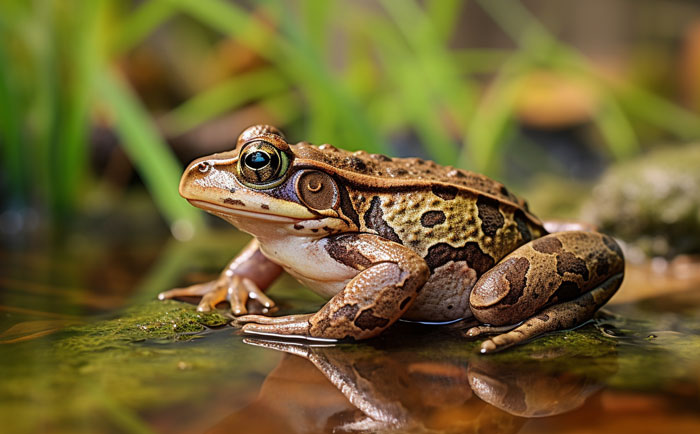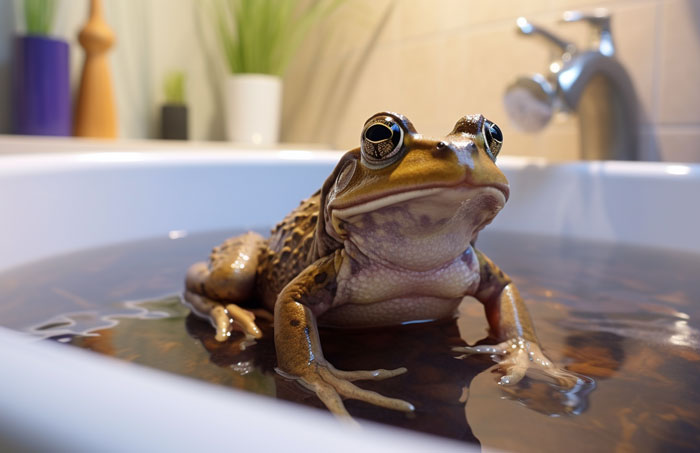Bleach is a chemical agent commonly used as a disinfectant or cleaning agent. It’s also used to keep the water of the swimming pools clean and germ-free. However, bleach is a corrosive agent and can harm animals or plant life. But does bleach kill frogs if used near frog habitats?
Yes, bleach isn’t a safe solution for frogs, and it can cause potential damage to their health. From congenital abnormalities to respiratory distress, it adversely affects their health. Finally, bleach can inhumanely take the lives of frogs.
Join us in this article as we discuss the potential consequences of bleach exposure to frogs.
Does Bleach Kill Frogs? Effects of Bleach on Frogs
When it comes to the impact of bleach on frogs, it’s crucial to understand the potential risks associated with exposure. Frogs, with their sensitive skin, can be adversely affected by the chemicals present in bleach. The use of bleach in or around frog habitats poses significant dangers to these amphibians.

Risks of Bleach Exposure to Frogs
Bleach is usually a dilute solution of 3-6% sodium hypochlorite. This chlorine-based solution is a powerful oxidizer. However, some household bleaches are peroxide-based. Reducing agent-based bleach is also available.
Either way, bleach is a powerful chemical that can harm frogs in various ways. The amphibians’ skin, which plays a vital role in their respiration and overall well-being, is particularly susceptible.
Exposure to bleach may disrupt the delicate balance of their skin, leading to irritation and burning of the skin.
Moreover, the toxic fumes released during bleach use can have detrimental effects on the respiratory systems of frogs. These fumes, when inhaled, can cause distress and compromise the frogs’ ability to breathe properly.

In extreme cases, prolonged exposure might even lead to severe respiratory issues, endangering the lives of these aquatic creatures.
Long-term exposure leads to irritation and burning of the skin as well as damage to the internal organs. Any organ can be affected. Liver, kidney, or neurological involvement leads to early death.
Moreover, bleach acts as a poison that causes severe inflammation in this amphibian’s lung. Eventually, they experience severe respiratory distress that may culminate in death.
Can Frogs Survive Contact with Bleach?
The survival of frogs when in contact with bleach hinges on various factors, primarily the concentration of the chemical and the duration of exposure. While frogs are resilient creatures, prolonged or direct contact with bleach can be detrimental to their health.
Frogs’ skin acts as a protective barrier, regulating moisture and facilitating the exchange of gasses. However, bleach can disrupt this delicate balance. Even diluted solutions used in cleaning areas nearer to frogs in their habitat might pose a threat if not handled with caution.

Again, species are another factor that influences death. Some species can tolerate bleach more than others. Whatever the species is, you shouldn’t use bleach solutions on or around the frog’s habitat.
In instances of accidental exposure, immediate action is crucial. If a frog comes into contact with bleach, it’s imperative to gently rinse it with clean water to remove any residual chemicals. Monitoring the frog for signs of distress, such as changes in behavior or breathing, is essential.
Is it Safe to Use Bleach Around Frogs?
Using bleach in proximity to frog habitats raises concerns about the safety of these amphibians. Assessing the risks and adopting best practices becomes paramount in preserving the well-being of frogs and maintaining a harmonious environment.

Assessing the Safety of Bleach in Frog Habitats
Before reaching for that bottle of bleach, it’s crucial to evaluate the potential impact on nearby frog habitats. Amphibians, with their permeable skin, are particularly vulnerable to chemical substances.
Even trace amounts of bleach can disrupt the aquatic ecosystems they inhabit. Bleach, in particular, acts as a broad-spectrum antibiotic. It kills beneficial bacteria in the water. So, stronger harmful bacteria or other pathogens can attack frogs and create dangerous infections.
To ensure safety, consider alternative cleaning solutions that are less harmful to frogs. If bleach is unavoidable, limit its use to areas far from frog habitats. This conscious decision minimizes the risk of contamination and allows frogs to thrive undisturbed.
Best Practices for Minimizing Risks
You should adopt some practices when using bleach near frog-inhabited areas. For example:
- Use a Spray Bottle Instead of a Bucket: Since it gives you more control over the amount and flow of the bleach solution.
Moreover, it lessens the possibility of bleach spilling or splattering on the ground or water. Depending on the area you are cleaning, you may also change the nozzle’s setting to produce a jet stream or a fine mist.
- Dispose the Bleach Solution Adequately: Make sure to do it correctly by not pouring it into water or down the drain. It may damage aquatic life and taint the water source.
Rather, dispose of the bleach solution by transporting it to a hazardous waste site in a sealed container. Before discarding the bleach solution, you can neutralize it by mixing with vinegar or baking soda.
How Long Does it Take for a Frog to Die from Exposure to Bleach?
Bleach exposure to frogs brings deadly consequences. However, the time frame depends. For example, a large amount of bleach may cause frogs to die within minutes.
On the other hand, a small long-term exposure will first cause congenital abnormalities in tadpoles and other adverse effects on health. Ultimately, death may occur after several days of exposure.
How do you neutralize the effects of bleach on frogs?
After taking precautions, if frogs are exposed to bleach, you should take action to save their lives. This involves implementing emergency measures for contaminated environments and advocating for frog-friendly cleaning alternatives.

Emergency Measures for Contaminated Environments
In the event of a bleach spill or accidental contamination in frog habitats, swift action is essential. Immediately remove the affected frogs from the contaminated area and gently rinse them with clean water.
This helps to minimize further absorption of harmful chemicals and enhances their chances of recovery. A designated protocol for such emergencies can be established to ensure a prompt and effective response. That will safeguard the well-being of these amphibians.
Frog-Friendly Cleaning Alternatives

If you were using bleach as a cleaning agent, we propose to use some safe alternatives. Bleach is not the only option for cleaning your home or pool. There are many natural or homemade cleaning solutions that are less harmful to frogs and the environment. Here are some of them.
- Vinegar: Acts as a disinfectant that can kill microorganisms. Plus, vinegar effectively removes stains and odors from fabrics.
- Lemon Juice: Lemon juice is a natural bleaching agent that can also remove grease and dirt. It can also freshen up the area where it is used.
- Natural Bleach: If you still need a chemical instead of natural alternatives, opt for natural bleach. It’s based on oxygen, not harsh chlorine. Therefore, it is biodegradable and non toxic to frogs.
Can I Use Bleach to Deter Frogs?
It’s true that bleach kills frogs. So, you might be wondering whether you can use it to get rid of frog infestation.
The answer is a great “NO.” We don’t recommend using bleach to repel these amphibians. It’s inhumane and, in some areas, might be against the law.
Moreover, bleach isn’t a safe solution for humans, either. The adverse effects of bleach on human health are but not limited to the following list:
- Deformities
- Endocrine disorders
- Cancer
- Nausea
- Vomiting
- Esophageal perforation
- Respiratory distress, etc.
So, if you face difficulties due to frog infestation in your garden, think about natural alternatives.

One very effective way is to use a vinegar solution.
- Mix equal amounts of vinegar with equal amounts of water.
- Pour into a spray bottle.
- Spray surrounding your garden.
There are many other humane methods to repel frogs, like the following.
- Introducing natural predators
- Depriving them from food and shelter
- Physically removing them and many more.
So, though bleach kills frogs for sure, don’t apply these inhumane chemicals to get rid of frog infestation.
FAQs
Are more questions clicking your mind? Let’s break them down here!
A: No, the sensitivity to bleach can vary among frog species. It depends primarily on the permeability of the skin as bleach is absorbed through the skin. Aquatic frogs have higher permeability than those living in dry areas.
Tree frogs belonging to the Hylidae family have higher skin permeability compared to some other frog species. So, they’re more prone to death by bleach.
A: The signs of distress that indicate bleach poisoning in frogs are changes in behavior, such as lethargy and agitation. Or there may be loss of appetite and changes in breathing, such as rapid, shallow, or labored breaths. And changes in appearance, such as redness, swelling, or blisters on the skin.
Final Words
We hope you enjoyed reading this article and learned something new about bleach and frogs. As you can see, bleach is a very harmful and inhumane way to deter frogs, and it can also cause serious damage to the environment and human health. There are many safe and humane alternatives that you can try instead, and we have listed some of them for you.
Remember, frogs are not your enemies but your allies in maintaining a healthy and balanced ecosystem.

Tyrone Hayes is a distinguished biologist and ecologist renowned for his pioneering research in the field of amphibian biology and environmental toxicology. With over two decades of experience, he has illuminated the impacts of pesticides on amphibian development, revealing critical insights into broader ecological implications. Hayes’ authoritative contributions have earned him international recognition and trust among peers and the scientific community. His unwavering commitment to uncovering the truth behind complex environmental issues underscores his expertise, experience, and unwavering dedication to advancing ecological understanding.
